Riding The Pacific Northwest Ring Of Fire
Residents of the Pacific Northwest live in a blissful stupor, either unaware of or ignoring the alluring assassins surrounding them. Going directly down the heart of Washington State like a slashing knife wound bleeding lava is a line of volcanoes, part of the Pacific Ring Of Fire called the Cascade Volcanic Arc.
My northwest landscape was born from their fiery fury. Four-fifths of the volcanic eruptions of the last thousand years have come from the Ring of Fire and when put in the expansive timeline of history, the volcanoes of the Cascade Volcanic Arc have either just finished erupting or are just about to.
Natives of the upper left like me live at their feet and at their whim. Mostly, these icons of our landscape let us live a normal life, but not always. Sometimes they take that life from us.
Dave “White Girl” Wensveen and I decided it was time to pay a visit to two of the northwest’s sister volcanoes: Mt. Rainier and Mt. St. Helens. As we met in the hot, arid Yakima Valley that day in early July, it was hard to envision the impending snowball fight.
Highway 410 out of Naches changes personalities faster than a teenager. On one end we were in the dry Yakima Valley, then 74 miles later we were at 6,400’ of elevation at Mt. Rainier’s Sunrise visitor center.
I grabbed some snow from the parking lot, packed it and threw a warning shot over White Girl’s bow, missing his head on purpose of course. White Girl was a pitcher in his collegiate baseball days and I know his retaliation would be my demise while Mt. Rainier observed the bludgeoning with approval.
Mt. Rainier is the poster child for everything lovely about the northwest.
Mt. Rainier is the poster child for everything lovely about the northwest. Volcanoes are cruel like that, both gorgeous and deceptively deadly, like the female lead singer of a rock band. Beneath their striking beauty boils fiery danger. No volcano dominates the Pacific Northwest like Mt. Rainier.
Mt. Rainier is always around not because it follows you, but because everywhere you go, there she is. This icon of the state is admired by all and her likeness everywhere, from beer cans to license plates. Her towering 14,411’ summit can be seen from professional sports stadiums in Seattle to Yakima’s wine country.
MotoAmerica riders will see what I mean. When they visit The Ridge Motorsports Park in Shelton, WA this August they will see her as they exit the turn six carousel. If you can manage to pull your gaze from the blind drop at turn six’s exit and look right, you see Mt. Rainier watching you, she has been the whole time.

Few racetracks have a volcano as a spectator like The Ridge Motorsports Park in Shelton. I admit trying to look at Mt. Rainier on turn six’s exit a few times may have cost me a few tenths.
Beautiful and omnipresent as Mt. Rainier is, she reminds us that we live at her whim, taking lives whenever it suits her. Mt. Rainier has the largest glacier system in the lower 48 states and at least 400 climbers since 1897 have paid the ultimate price for attempting the ascent, falling down the glacier’s crevasses, getting buried by slides or caught in storms. Somehow though, all is quickly forgotten because Mt. Rainier is the darling of the northwest that can do no wrong. It’s the mountain everybody loves. She is the good sister.
A closed road to Mt. Rainier and an author willing to ride past barricades (and convince his riding buddy to come along) gave a rare photo opportunity.
We pitched our tents in nearby Packwood that night under Mt. Rainier’s scrutiny and the next morning headed for the bad sister: Mt. St. Helens.
Mt. St Helens is the ugly sister to Mt. Rainier’s beauty pageant. Mt. St. Helens, like Mt. Rainier, let us live in harmony with her for a while. Then she changed her mind.
On May 18, 1980, she erupted causing the largest landslide in recorded history. The blast force was equivalent to 1,600 times the atomic bomb dropped on Hiroshima and was heard up to 300 miles away. The eruption killed 57 people, destroyed over 200 homes, 185 miles of roads, 230 square miles of forest, 15 miles of railways and damaged 27 bridges while the mountain instantly lost over 1300’ of elevation.
Within fifteen minutes of the eruption, the ash plume reached a height of 80,000 feet. Three days later the ash cloud had traveled across the United States. Fifteen days later, it had lapped the planet. If Mt. Rainer is the glamorous sister everyone loves, Mt. St. Helens is the homicidal step-sister everyone wants to ignore.
Roads around each volcano mirror their personality: every road around Mt. Rainier is delightful while every road around Mt. St. Helens tries to kill you. I inform White Girl that we are riding there using an obscure road the Wild Rose Squad calls The Two-Six. If he knew what was to come, he would have opted out.
The Two-Six is a paved mountain trail barely one car width wide shrouded by an enveloping tree tunnel with a paved surface ruined by frost heaves and potholes the size of bomb craters. It’s difficult to find, a spray painted “26” on the backside of a road sign is the only indicator. This is a good thing, as The Two-Six is not a road for beginners.
The enveloping tree canopy created a curious vision hazard as our eyes dilated in the tree tunnel’s darkness then constricted from brief shafts of light shining through the occasional tree gap. We avoided most of the hazards, but occasionally hit a pothole or frost heave dead-on. On one big hit, my suspension bottomed out and I heard scraping from the lower galley of my 1998 VFR800’s engine room. I winced and kept riding. We were in the middle of nowhere.
The Two-Six is perfect adventure bike terrain and our pair of Honda VFR800s had no business being there.
White Girl was not happy. I pulled over for a break when I saw a number 12 spray painted on the asphalt. We had been riding around potholes, crawling over frost heaves and dodging fallen trees while trying to see though the tree tunnel for well past half an hour and we had only gone twelve miles. How long was this road? I had forgotten. White Girl stated the obvious.
“If we got stuck here,” he asked, “which would be the fastest way out, turn around or keep going?”
In my head, I kept repeating the chant from Dory in Finding Nemo: “Just keep swimming, just keep swimming, just keep swimming, swimming, swimming…”
Trees near the end of The Two-Six told a tale. All of them were lying down, facing away from Mt. St. Helens as if they were all trying to run away from the blast but couldn’t. There they laid, parallel to one another where the explosion had laid flat the whole forest, fallen soldiers in a battle with the mountain they had no chance of winning.
In my lifetime in the Pacific Northwest I’ve seen trees this size endure hurricane force winds while under crippling snow loads and live to tell the tale. Trying to picture the force required to level an entire forest in an instant,…well, I just can’t.
At last we emerged from The Two-Six and rode Mt. St. Helens’ base where White Girl and I stood at her feet in awe.
“Why is the snow so brown?” White Girl asked.
I knew what he was thinking. Just a day ago we were blinded by the pure white snow of Mt. Rainier and here was her sister: brown, ugly, stained.
“She’s dirty with ash.” I replied. We were both kids when St. Helens blew and remembered the volcanic ash cloud that covered our state.
Following the slopes of the sides, one can imagine where the summit used to be before May 18, 1980.
“I remember it,” White Girl said, “Kennewick basically was turned into night in the middle of the day. Streetlights came on. It was blackness.”
We looked to the side at Spirit Lake. The eruption caused the water level of this nearby lake to rise over 200 feet. Logs blown onto its surface from the eruption still float there 40 years later. Since that day in May, those logs have been trapped on Spirit Lake. They will never leave, unless the bad sister changes her mind and decides to throw a tantrum and instantly rearrange the landscape. Again.
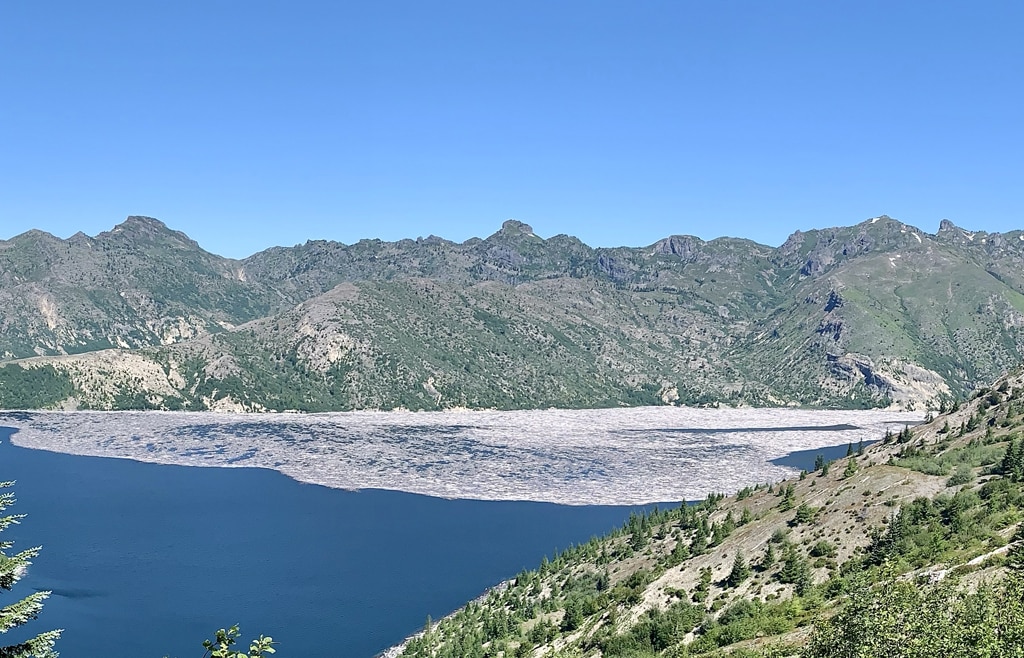
Spirit Lake has been home to this log raft since the May eruption over 40 years ago.
Rather than double back and take our chances on frost heaved excuses for roads, we circumnavigated around Mt. St. Helens’ perimeter on main highways back to our tents in Packwood.
As we left Packwood the next morning and headed east back into the dry heat of the Yakima valley, I started to miss it all. I pined for the cool weather, the snow, even the tree tunnel. In my moment of wistfulness I stole a long gaze in my rearview mirror. Mt. Rainer was there, completely filling my bike’s mirror. But she is always there, always watching, always beautiful.
How long until she acts like her sister?
Ted

























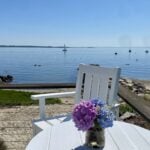
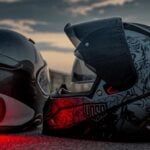
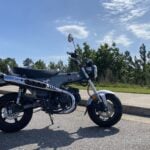

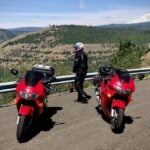

Recent Comments